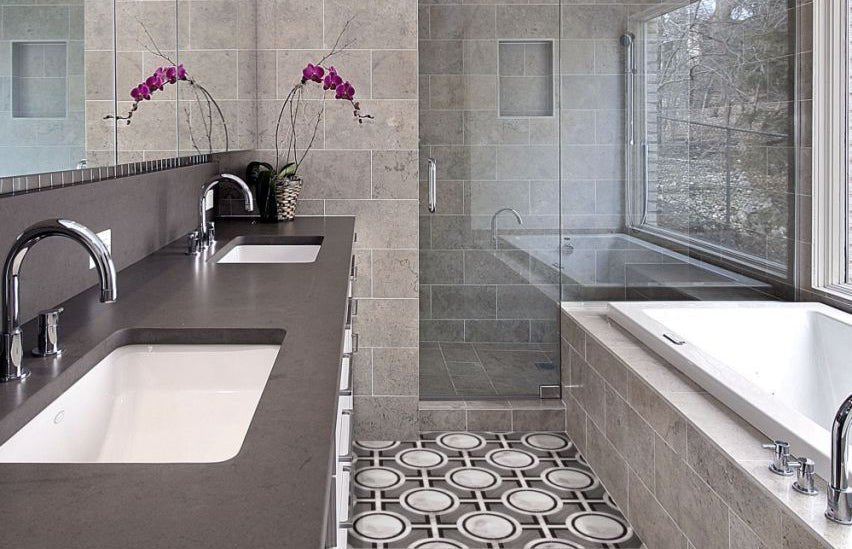
Travertine Vs. Limestone Tile: The Pros & Cons of Each with Example Designs
Travertine is a type of “preliminary” limestone, but that is where the similarities end. Travertine is a much softer product than limestone and has its own remodeling uses. Both travertine and limestone occur at the bottom of oceans, river and lake beds, where the shells of dead aquatic creatures collect. These shells end up being compacted, forming calcium carbonate. The difference between travertine and limestone occurs when the layers of sedimentary rock end up being subjected to more pressure and heat, making it limestone instead of travertine. When comparing travertine vs limestone, travertine just accumulates the layers without the heat and pressure necessary to convert it to limestone. You wouldn’t think that is much of a difference, but when it comes to remodeling, it creates unique opportunities for design with each type of stone. Here are some of the pros and cons of travertine and limestone.
#1 The Pros and Cons of Picking Design Colors
The choice of colors is very important in any remodeling scheme. If you want a light, airy, feel, it’s natural to pick lighter shades. Limestone has bright, white, and champagne-like colors that are consistent throughout the stone, whereas travertine tends towards a darker palette with long streaks embedded in it. Palazzo Limestone, however, come in darker colors and are perfect for those peaceful and earth-friendly Zen-like designs that incorporate a lot of grays, browns, and blacks. The brightest and lightest travertine colors can approximate limestone, but may be a shade darker, like this Ivory Dark. Travertine will complement that color scheme easily. Thus, I wouldn’t call only having darker tones a travertine con, it does limit you in small spaces or where the palette needs to be lighter, however.

Antique Limestone - View Details »
#2 The Pros and Cons of Stone Hardness on Your Design
Since travertine is a softer product, it is not as suitable for floors as much as limestone, but it can be stunning as a backsplash, on countertops and along walls. Limestone is ideal for high traffic areas. It can withstand a lot of wear and tear and still look good. It doesn’t mean that travertine can’t be used on floors, however, but only it should be filled with resin and polished to increase the durability when used in floor design. Just look at this beautifully polished travertine floor! Travertine is far more porous and can end up being stained or discolored without a surface treatment and regular maintenance.
 Travertine Floor - View Details »
Travertine Floor - View Details »
#3 The Pros and Cons of Long-Term Maintenance
Since travertine floor tiles typically are filled with resin, it can end up separating from the stone over time. This will cause more maintenance issues as the tile ages. That’s why it is recommended to reseal your travertine tiles every 3 to 4 months. Natural travertine, that is the stone that is unfilled and used for walls, ends up having pock marks and voids that make it difficult to keep clean. Thus, if you opt for natural stone without a filler, you’ll end up still having trouble keeping it clean. The good news is that travertine’s dark colors tend to hide the dirt that might accumulate on its surface. Limestone, on the other hand, once sealed is not as porous and can be easily dust mopped to keep it clean. It too requires periodic sealing to keep it looking its best. And it also can come in darker colors, like this beautiful Zen bathroom wall.

#4 The Pros and Cons of Stone Choices with Underfloor Heating
You really can’t use travertine with underfloor heating because of the resin fillers I mentioned earlier. However, limestone makes an excellent choice for underfloor heating. Since it was created in areas of high pressure and heat, it is perfectly happy to be in this environment once again. This contemporary limestone bathroom shows you the possibilities of using it everywhere, even on the bathtub surround, and with underfloor heating.

Limestone Tile - View Details »
#5 The Pros and Cons of Cost Versus Longevity
Travertine is a less expensive choice than limestone, but that is because it is higher in maintenance and doesn’t last as long. Travertine is also water-absorbent so that it can get damaged by the weather if you are in a zone that experiences freezing fluctuations. However, it is still an exceedingly beautiful choice inside the home and can even be used on floors, with the proper maintenance. Limestone can cost more, but it will last longer with proper maintenance, simply because it isn’t filled with resins. However, even natural travertine will not last as long as limestone because the stone is simply less durable.

Basketweave Tile - View Details>>
#6 The Pros and Cons of Travertine Vs Limestone in Pool Designs
Travertine can be used in pool designs, where freezing is unlikely to occur. The fact that the travertine will be exposed to water on a regular basis makes is less suitable for freezing zones, where the water absorbed by the stone can end up expanding when frozen, causing damage. It tends to have less of a grip than limestone, which is also a consideration when designing pool areas. It can also reflect the sun more producing more glare during sunny days than limestone is apt to do. For these reasons, for pool areas and bathrooms only, limestone is typically favored over travertine, as it has more of a grip and is able to withstand a harsh environment that includes water, hot sun, and winters without too much fuss.

Arabesque Tile - View Details>>
